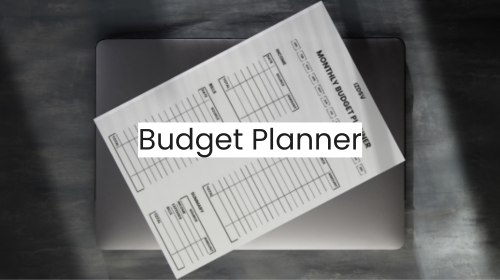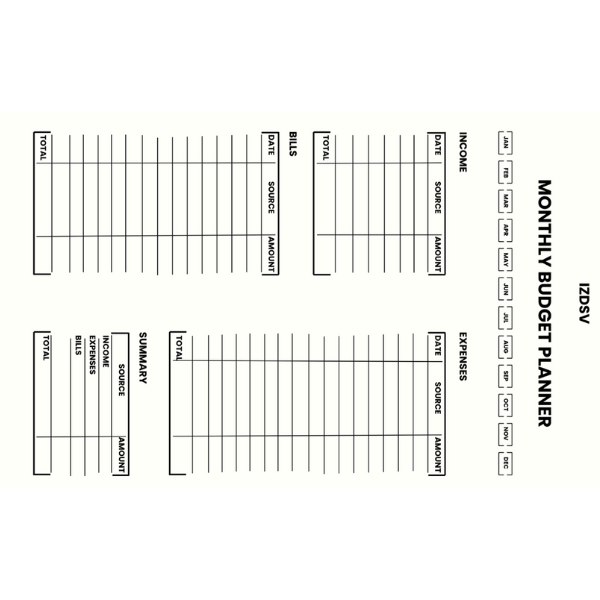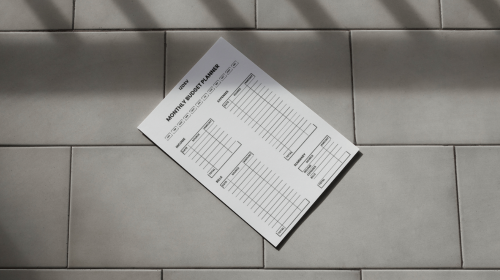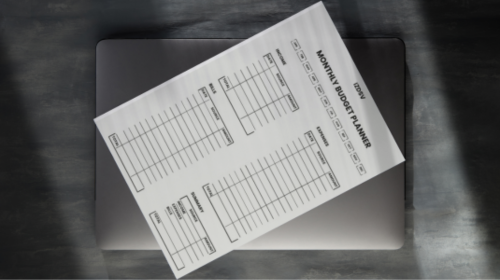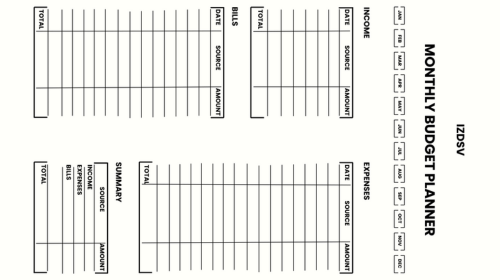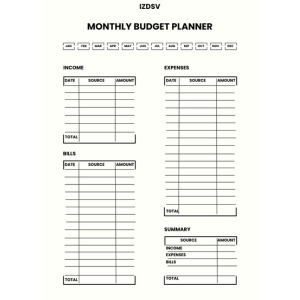Mastering Your Monthly Cash Flow with Templates
What is Cash Flow and Why Does it Matter?
Cash flow refers to the movement of money in and out of an individual’s or business’s accounts over a specific period. It includes:
- Inflows: Income, investments, loans received
- Outflows: Expenses, debt payments, investments made
Cash flow matters because it’s crucial for day-to-day financial operations and long-term financial health. Good cash flow management ensures you have enough money to cover your expenses and obligations when they’re due.
How Does Cash Flow Impact Your Financial Health?
Cash flow significantly impacts financial health in several ways:
- Liquidity: Positive cash flow provides readily available funds for unexpected expenses or opportunities.
- Debt management: Consistent positive cash flow makes it easier to pay off debts and avoid late fees.
- Investment opportunities: Excess cash flow can be invested for future growth.
- Stress reduction: Knowing you can cover your expenses reduces financial anxiety.
- Credit score: Timely bill payments, facilitated by good cash flow, positively impact your credit score.
What Are the Common Cash Flow Challenges Individuals Face?
Some common cash flow challenges include:
- Irregular income: Freelancers or those with seasonal work may struggle with inconsistent cash inflows.
- Overspending: Poor budgeting can lead to cash shortfalls.
- Unexpected expenses: Emergency costs can disrupt cash flow if not prepared for.
- Debt obligations: High debt payments can strain monthly cash flow.
- Timing mismatches: When bill due dates don’t align well with income receipt dates.
- Inadequate savings: Lack of an emergency fund can lead to cash flow problems during unexpected events.
What Are Cash Flow Templates and How Do They Work?
Cash flow templates are pre-designed spreadsheets or forms that help individuals and businesses track and analyze their cash inflows and outflows over time. They work by:
- Providing a structured format to input income and expenses
- Automatically calculating totals and cash flow balances
- Offering visual representations of cash flow trends
- Helping forecast future cash positions
These templates typically organize financial data on a weekly, monthly, or annual basis, allowing users to see their financial picture at a glance.
What Types of Cash Flow Templates Are Available?
There are several types of cash flow templates available, including:
- Personal cash flow templates: For individual budgeting and financial planning
- Business cash flow templates: For tracking company finances
- Investment property cash flow templates: Specifically for real estate investors
- Project cash flow templates: For managing finances of specific projects
- Retirement cash flow templates: For planning post-retirement finances
Templates can range from simple spreadsheets to more complex tools with advanced features and integrations.
How Can Templates Simplify Your Cash Flow Management?
Templates can simplify cash flow management in several ways:
- Standardization: Provides a consistent method for tracking finances
- Time-saving: Eliminates the need to create a tracking system from scratch
- Error reduction: Automated calculations minimize math errors
- Visual representation: Many templates include charts or graphs for easy comprehension
- Forecasting: Helps predict future cash positions based on historical data
- Organization: Keeps all financial information in one place
What Features Should You Look for in a Cash Flow Template?
Key features to consider in a cash flow template include:
- User-friendly interface: Easy to input data and understand results
- Customization options: Ability to add/remove categories to fit your needs
- Automated calculations: Reduces manual work and potential errors
- Visual reports: Graphs or charts to visualize cash flow trends
- Forecasting capabilities: Projections based on historical data and future estimates
- Multiple time frames: Ability to view data weekly, monthly, quarterly, and annually
- Export/import functionality: Easy to share or backup data
- Password protection: For sensitive financial information
How to Create Your Own Cash Flow Template
To create an effective cash flow template, you’ll need to:
- Identify your financial goals and tracking needs
- Determine the time period you want to track (e.g., monthly, quarterly)
- Decide on the categories for income and expenses
- Choose a format that’s easy for you to use and understand
What Information Do You Need to Gather?
You’ll need to collect:
- Income sources: Salary, freelance work, investments, etc.
- Fixed expenses: Rent/mortgage, utilities, insurance, loan payments
- Variable expenses: Groceries, entertainment, transportation
- Savings and investments
- Debt information
- Seasonal or one-time expenses
How Do You Structure Your Cash Flow Template?
A basic structure might include:
Income section:
- List all income sources
- Total income calculation
Expenses section:
- Fixed expenses
- Variable expenses
- Total expenses calculation
Net cash flow:
- Income minus expenses
Running balance:
- Previous balance + current net cash flow
Notes section:
- For explanations or reminders
What Tools Can Help You Design Your Template?
Several tools can assist in creating your template:
- Spreadsheet software: Microsoft Excel, Google Sheets
- Accounting software: QuickBooks, FreshBooks
- Specialized budgeting apps: YNAB, Mint
- Design tools: Canva (for more visual templates)
Implementing Your Cash Flow Template Effectively
Consistent Updates
Regularly updating your template is key to its effectiveness. Here’s how to approach it:
- Set a specific day each month for updates (e.g., the 1st or the day after payday)
- Use calendar reminders or apps to prompt you
- Spend 15-30 minutes reviewing and updating your template
Data Accuracy
Ensuring your data is accurate is vital:
- Keep all receipts and bills
- Use online banking or financial apps to track expenses
- Double-check entries to avoid errors
Analysis and Goal-Setting
Don’t just input data – use it to inform your financial decisions:
- Compare actual figures to your budget
- Identify trends in your spending
- Set realistic financial goals based on your cash flow patterns
Adjustments
Be prepared to make changes:
- If certain categories consistently over or under-run, adjust your budget
- Add or remove categories as your financial situation changes
Planning for Uncertainties
Use the template to prepare for unexpected expenses:
- Regularly review the “Unexpected Expense Planning” section
- Update probabilities and estimated amounts as your situation changes
- Ensure your emergency fund is growing to cover potential expenses
Technology Integration
Consider using technology to streamline the process:
- Link your template to your bank accounts for automatic updates
- Use budgeting apps that can export data to your template
Regular Reviews
Schedule more comprehensive reviews periodically:
- Monthly: Quick check on cash flow and unexpected expenses
- Quarterly: Deeper analysis of trends and progress towards goals
- Annually: Comprehensive review and planning for the next year
How Often Should You Update Your Cash Flow Template?
The frequency of updates depends on your financial situation and goals, but here are some general guidelines:
- Monthly: This is the most common and often most effective frequency. It allows you to track your finances closely without becoming overly time-consuming.
- Weekly: If you’re trying to stick to a tight budget or dealing with irregular income, weekly updates can provide more immediate feedback.
- Quarterly: For those with very stable finances, quarterly updates might suffice, but this is less common for personal finance.
- Real-time: Some people prefer to update their template as transactions occur, which can work well if you’re using a digital tool or app.
What Strategies Can Help You Stay on Track with Your Cash Flow?
Several strategies can help you maintain good cash flow management:
- Set reminders: Schedule regular times to update your template.
- Automate where possible: Use bank feeds or financial apps that can automatically categorize transactions.
- Review regularly: Don’t just input data, but analyze it to understand your spending patterns.
- Set goals: Use your template to set and track financial goals.
- Be consistent: Use the same categories and update frequency to make trend analysis easier.
- Adjust as needed: If your template isn’t working for you, don’t hesitate to modify it.
How Can You Use Your Template to Prepare for Unexpected Expenses?
Your cash flow template can be a powerful tool for preparing for unexpected expenses:
- Emergency fund tracking: Include a row for contributions to and withdrawals from your emergency fund.
- Scenario planning: Use your template to model “what-if” scenarios (e.g., job loss, major repair).
- Seasonal expense anticipation: Look for patterns in your historical data to anticipate and budget for irregular expenses.
- Surplus allocation: When you have a positive cash flow, decide in advance how to allocate any surplus.
Common Mistakes to Avoid When Using Cash Flow Templates
Some of the most frequent errors include:
- Forgetting to include all income sources or expenses
- Misclassifying expenses (e.g., putting variable costs under fixed expenses)
- Not reconciling the template with actual bank statements
- Failing to adjust the template as financial situations change
- Ignoring seasonal variations in income or expenses
What Are the Pitfalls of Overcomplicating Your Template?
Overcomplicating your template can lead to several issues:
- Time-consuming updates: An overly complex template may discourage regular use.
- Analysis paralysis: Too much detail can make it hard to see the big picture.
- Increased error risk: More complexity means more opportunities for mistakes.
- Reduced flexibility: Overly specific categories may not adapt well to changing circumstances.
- Difficulty in interpretation: Complex templates may be hard for others (e.g., family members) to understand.
How Can Inaccurate Data Impact Your Cash Flow Management?
Inaccurate data can have serious consequences:
- Misguided decision-making: Incorrect information leads to poor financial choices.
- False sense of security: Overestimating income or underestimating expenses can lead to overspending.
- Missed opportunities: Inaccurate data might cause you to miss chances for savings or investments.
- Budget failures: If your template doesn’t reflect reality, your budget is likely to fail.
- Stress and anxiety: Discovering large discrepancies can cause financial stress.
What Are the Consequences of Neglecting Regular Updates?
Failing to update your cash flow template regularly can result in:
- Outdated financial picture: Your template won’t reflect your current situation.
- Missed trends: You might not notice gradual changes in your spending or income patterns.
- Surprise shortfalls: Without regular updates, you may be caught off guard by cash flow issues.
- Ineffective budgeting: Your budget becomes less useful if it’s based on old data.
- Missed goals: Without regular check-ins, you may lose track of your financial goals.
Taking Control of Your Cash Flow
Understand Your Current Position
Start by getting a clear picture of where you stand financially. This involves:
- Calculating your total monthly income from all sources
- Listing all your regular expenses, both fixed and variable
- Identifying any debt you have and the associated interest rates
- Assessing your current savings and emergency fund
Use Your Cash Flow Template
Leverage the simple cash flow template to track your finances. Remember to:
- Update it regularly (at least monthly, preferably weekly)
- Be honest and accurate with your entries
- Use it to identify spending patterns and areas for improvement
Create a Realistic Budget
Based on your cash flow data, create a budget that:
- Covers all necessary expenses
- Allocates money for savings and debt repayment
- Allows for some discretionary spending
- Is flexible enough to adjust as needed
Build an Emergency Fund:
Start or continue building an emergency fund that can cover 3-6 months of expenses. This helps you avoid going into debt when unexpected costs arise.
Manage Debt Wisely
If you have debt, create a repayment strategy:
- Focus on high-interest debt first
- Consider consolidation or refinancing options
- Avoid taking on new debt if possible
Increase Your Income
Look for ways to boost your cash inflow:
- Ask for a raise at work
- Start a side hustle
- Sell items you no longer need
Reduce Unnecessary Expenses
Review your spending and cut costs where possible:
- Cancel unused subscriptions
- Find cheaper alternatives for regular purchases
- Reduce energy consumption to lower utility bills
Plan for the Future
Use your improved cash flow management to set and work towards long-term financial goals:
- Saving for retirement
- Investing for wealth building
- Planning for major purchases or life events
Stay Educated
Continuously improve your financial literacy:
- Read personal finance books or blogs
- Attend financial workshops or webinars
- Consider working with a financial advisor for personalized guidance
Review and Adjust Regularly
Financial management is an ongoing process. Make it a habit to:
- Review your cash flow monthly
- Adjust your budget quarterly
- Reassess your financial goals annually
What Are the Key Takeaways for Effective Cash Flow Management?
Key takeaways for effective cash flow management:
- Awareness: Understanding your income and expenses is fundamental.
- Consistency: Regular updates and reviews are crucial for accurate financial tracking.
- Simplicity: Keep your system manageable to encourage consistent use.
- Flexibility: Be ready to adjust your cash flow statement template and strategies as your financial situation changes.
- Planning: Use your cash flow projection data to set goals and prepare for unexpected expenses.
- Accuracy: Ensure your data is correct to make informed financial decisions.
- Analysis: Don’t just record data – use it to identify trends and improve your financial health.
How Can You Start Implementing These Strategies Today?
How to start implementing these strategies today:
- Set Up Your Template: Use the enhanced cash flow template we created earlier. If you haven’t already, you can start by inputting your current financial data.
- Establish a Routine: Choose a specific day and time each week for quick updates, and each month for more thorough reviews. Set reminders on your phone or calendar.
- Gather Financial Documents: Collect recent bank statements, bills, and receipts. This will help you input accurate historical data and set realistic budgets.
- Start Tracking Immediately: Begin recording your income and expenses right away. Don’t wait for the “perfect” time – the sooner you start, the better.
- Set Initial Goals: Based on your current financial picture, set some initial goals. These might include building an emergency fund, reducing debt, or saving for a specific purchase.
- Plan for the Unexpected: Use the “Unexpected Expense Planning” section of your template to list potential future expenses.
- Educate Yourself: Commit to learning more about personal finance. This could involve reading financial blogs, books, or taking online courses.
- Involve Others: If you share finances with a partner or family members, involve them in the process. This can help ensure everyone is on the same page financially.
- Use Technology: Consider using budgeting apps or financial software that can sync with your bank accounts for easier tracking.
- Review and Adjust: After a month of using your new system, take time to review how it’s working. Be prepared to make adjustments to your free cash flow template or process as needed.

